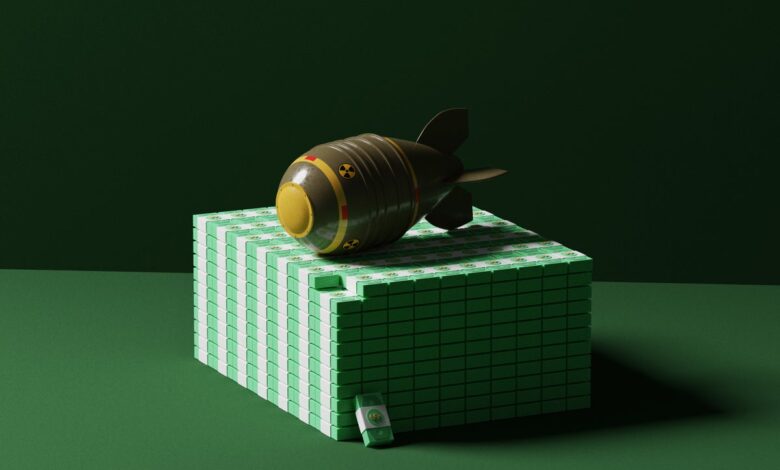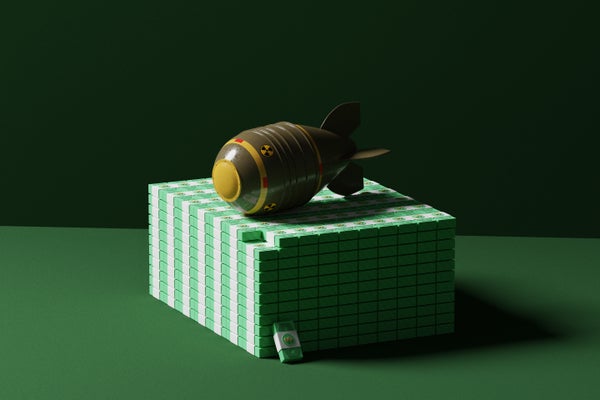
February 5, 2025
4 min read
Elon Musk Can Find His $2-Trillion Federal Spending Cut in Nuclear Weapons
DOGE’s Elon Musk should turn his $2-trillion hatchet to wasteful and perilous U.S. nuclear weapons modernization plans

Famously fortunate, Elon Musk now faces a rare opportunity—delivering on one of his signature overblown promises. From his newly created White House cost-cutting desk, all Musk must do is recommend ending one of the most misguided, wasteful and dangerous programs contemplated by the U.S. government, one that Scientific American has pushed for elimination.
Last November Musk set an ambitious target for his Department of Government Efficiency (DOGE), the meme-coin-joke name for his cost-cutting office, his reward for bankrolling Trump’s campaign. Under DOGE, Musk said he would trim $2 trillion from the federal budget. That’s a hefty sum even for the space mogul now regarded as the $400-billion-worth wealthiest man on Earth. (Musk subsequently downplayed $2 trillion as a “best-case outcome.”)
Luckily for him, there is one big, fat target with just that price tag, already sitting in Uncle Sam’s shopping cart, and it’s ripe for cutting: nuclear weapons. In 2010 Trump’s nemesis, then president Barack Obama, first proposed “modernizing” the U.S. triad of land-, sea- and air-based weapons over more than three decades. Almost unnoticed outside of national security circles, the initiative’s $1-trillion sticker price has nearly doubled and, as American University national security scholar Sharon Weiner wrote last year, “is likely to escalate even further by 2050—the supposed end date for modernization.”
On supporting science journalism
If you’re enjoying this article, consider supporting our award-winning journalism by subscribing. By purchasing a subscription you are helping to ensure the future of impactful stories about the discoveries and ideas shaping our world today.
Conveniently enough for Musk, his new boss, Trump, called in January for talks on reducing nuclear weapons with China and Russia, while speaking to the World Economic Forum in Davos, Switzerland. “Tremendous amounts of money are being spent on nuclear, and the destructive capability is something that we don’t even want to talk about today, because you don’t want to hear it,” Trump said. “It’s too depressing.”
Trump is right. DOGE should listen to him. Have at it, you noble knights of slaying government waste. We don’t need more than $140 billion worth of intercontinental ballistic missiles (ICBMs) planted across the Midwest, their overall cost jumping 37 percent last year, triggering a “critical breach” of federal budget rules. Budget-busting price increases have also dogged the National Nuclear Security Administration’s efforts to manufacture more plutonium “pits,” hollow metal spheres made of plutonium that when compressed, trigger nuclear explosions, of which we already have plenty, in old weapons. Dogged by delays, pit facility costs have jumped to as much as $37 billion, roughly quadrupling initial estimates. “I know that’s a lot of money,” said NNSA administrator Jill Hruby, last April. “However, I am much more confident in this estimate than earlier estimates in part, because it is more consistent with other recent similar projects,” she added, citing six over-budget $73.2 billion nuclear reactors in France and three $50-billion-plus highway projects in the U.S.
I have no idea why those numbers would be reassuring.
Costs aside, the bottom line is that more nuclear weapons make us less safe, the chief lesson of the cold war arms race. Amnesia seems to have overtaken awareness of the threat to humanity of nuclear warfare— hundreds of millions of immediate deaths, followed by nuclear winter starving billions. Even a limited nuclear war would cause global famine.
Nevertheless, China is ratcheting up its nuclear forces—to perhaps 900 weapons—over fears of a U.S. first strike with its modernized weapons. Meanwhile Russia has signaled it wants to head off a nuclear weapons buildup with the coming expiration of the New START Treaty, which limits both nations to 1,550 deployed nuclear warheads. Conditions are ripe for the rarest of Trumpian “deals,” one that succeeds, and prevents a three-way rerun of the cold war’s fruitless, perilous warhead race.
Inevitably, standing in the way of a sensible DOGE call for cutting back on nukes and heading to the treaty table is Project 2025, the far-right-authored blueprint for the Trump presidency. Among its calls: “Expand and modernize the U.S. nuclear force so that it has the size, sophistication, and tailoring to deter Russia and China simultaneously.”
In other words, start a new arms race.
Among its many other terrible ideas, Project 2025 calls for the Navy to develop an unneeded, unwanted, nuclear-armed, sea-launched cruise missile to further frighten China; restart nuclear tests whose fallout spread cancers among tens of thousands of Americans during the cold war (despite the Comprehensive Nuclear Test Ban Treaty) and deploy space-based weapons, something we’ve warned the Russians against for years. “Should these recommendations be implemented, they will result in a sharp decline in the security of Americans and a dramatic increase in the risk of regional and global conflicts,” wrote national security analyst Joseph Cirincione, in July, for the Bulletin of the Atomic Scientists.
Only Richard Nixon could go to China. After installing an unqualified Fox TV host atop the Department of Defense, surely Trump can take on the nuclear military-industrial complex. His designated cost-cutter, Musk, has already questioned one U.S. Air Force (and congressional) sacred cow, the famously overpriced F-35 fighter. By nixing nukes’ modernization, Musk could take that big $2-trillion bite out of the federal budget. That would be much more real, and smarter, than the imaginary trillions that Trump’s budget director paused in January to sniff for “woke gender ideology, and the green new deal,” among other targets, on the federal books.
Granted, Musk first promised to make his $2-trillion cuts a one-year reduction of the budget, not one playing out over decades like nuclear modernization. But it wouldn’t be the first time one of his promises suffered some shrinkage. He has cited the risk of “some doomsday event” as a reason for shipping humanity to Mars. DOGE gives him, and the Trump administration, a chance to help head off a nuclear disaster on Earth, one doomsday event that sits in plain view for all of us. That just might give his oversized Mars promises a little extra time to pan out.
This is an opinion and analysis article, and the views expressed by the author or authors are not necessarily those of Scientific American.
Source link





